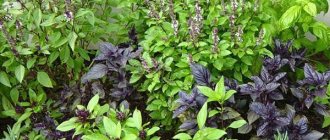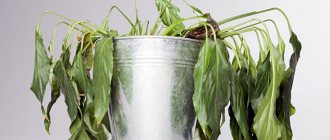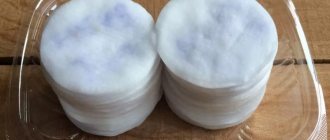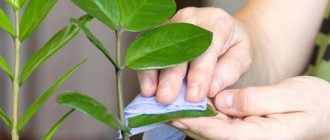/Accessories and decor/Gardening/
Basil is ideal for growing at home, as it is not fussy, grows both in winter and summer, looks nice and smells very tasty. If you are new to home gardening, we recommend starting with planting this particular herb! In this material you will find everything about how to grow basil on a windowsill, how to care for it and pinch it correctly to get as much harvest as possible.
Unique properties of basil
Basil is widely used in medicine and cooking. It has many positive properties. The plant has an analgesic, antiseptic, bactericidal, diaphoretic, antispasmodic and expectorant effect on the body.
Basil is a universal home remedy that relieves many symptoms.
Basil is used in the treatment of:
- bronchitis;
- asthma;
- tuberculosis;
- urolithiasis;
- hyperemia (increasing the amount of blood supplied to any part of the body);
- cardiovascular and skin diseases;
- conjunctivitis;
- gastroenteritis;
- rheumatism;
- measles;
- headaches;
- caries;
- tartar and plaque;
- pathologies resulting from radiation damage.
In addition, basil strengthens the immune system well.
It is not surprising that many gardeners prefer to grow basil indoors. After all, the plant contains a large amount of potassium, due to which its consumption helps lower blood pressure.
Basil is a healthy and tasty spice
There is a positive effect of basil on a person’s emotional state. The plant helps reduce stress, reduce feelings of nervousness and anxiety. Vitamin A, C, essential mass and phytonutrients included in its composition rid the body of free radicals and help prolong youth.
However, basil also has negative characteristics. Its overdose can cause poisoning. When it comes into contact with mucous membranes, the plant causes irritation. Its use is contraindicated during pregnancy, with vein thrombosis and blood clotting disorders. Thus, despite the wide list of positive properties of this plant, it is strictly not recommended to use it without consulting a doctor.
Basil should be used correctly to avoid harming yourself.
In cooking, basil is used in the preparation of ketchups, sauces, dressings, gravy, and sandwich butter. It is added to products during smoking and canning. It improves the taste characteristics of sausages, pates, omelettes, and salads.
This plant goes well with parsley, tarragon, mint, coriander and marjoram. But it should be borne in mind that basil has a fairly rich aroma that can overpower the smells of other spices. Therefore, it should be used in moderation.
What container to plant in?
Any pots are suitable for growing basil on a windowsill. But it’s better if they are square or rectangular (convenient to place on a windowsill) and always have holes in the bottom. They retain the required amount of moisture well, protect the root system from damage and can be used for more than one season in a row.
Peat pots work very well. There is no need to remove seedlings for replanting, and the peat itself, gradually rotting, turns into a nutritious fertilizer. Disadvantages include: rapid deterioration from water, risk of mold.
Have you already grown herbs on your windowsill?
Yes
No
How to properly transplant an adult plant into a pot on the eve of winter?
Basil is transplanted when growing the crop in open ground. In this case, in August or September the plant must be moved to a pot so that it is not damaged during the cold period. The soil composition is prepared in the same way as when planting cuttings. The volume of the pot should reach 2 liters.
Basil is replanted to protect it from winter frosts.
The transplant has the following features:
- First, a drainage layer is placed in the pot. Then they fill it with soil, in which they make a hole where water is poured.
- When the moisture is absorbed, carefully dig up the bush, remove it along with the earthen lump and move it into a pot. In this case, it is necessary to ensure that the roots are not damaged or bent.
- The plant is covered with soil and lightly compacted. If during the replanting process some parts of the bush were damaged, they should be cut off.
Growing conditions
Basil is an annual plant with a relatively short growing season. By regularly taking new cuttings, you can grow a plant from one pot purchased at the supermarket for quite a long time. The plant is easy to care for and grows well in the garden, on the balcony, and on the kitchen windowsill. It can be grown all year round. It doesn't take much effort to always have fresh leaves on hand, adding a pleasant taste and aroma to any dish.
Lighting, temperature
As a southern plant, basil prefers a warm, sunny location, protected from the wind. The more light, the more essential oil and the stronger the aroma of the leaves.
In a pot at home, basil usually grows to a height of 20-30 cm (in the garden - up to 50 cm). When growing basil, remember to water regularly and that the plant likes a sunny position. A kitchen without windows is definitely not suitable. It is worth moving the plant to the windowsill or putting it on the balcony in the summer. Warmth and sun are important for aromatic herbs. The sun is a guarantor of healthy growth. However, observations show that this grass grows well in partial shade, and too much sun in the summer on a southern balcony can be harmful - the soil dries quickly and the leaves turn pale.
Plants require a minimum of 5 hours of sunlight per day. The pots are installed in a place protected from strong winds and heavy rain. During the growing season, the air temperature should be maintained at 20-25 °C. Plants do not like temperatures below 12 °C. In cold weather, growth is severely limited or stopped completely.
Attention! Basil varieties with green leaves like sunny positions or light partial shade. Varieties with red leaves - only in sunny places (they are more demanding of light).
If the air temperature outside meets the needs of this herb, a bed in the garden is healthier for it than constantly being on the windowsill behind glass. Basil should receive:
- warm place;
- a lot of sun or partial shade;
- protection from rain and wind.
Young seedlings, recently purchased or grown at home, should gradually get used to sunlight. Therefore, they should be taken out onto the balcony for a short time at first. After a week or two of hardening, the sun no longer threatens the leaves.
Priming
If the plant was purchased in a pot, the soil may be of low quality, therefore, it is better to transplant the plant into a new, large pot. This will help in the development of the plant, which forms a large root system that requires a lot of space. You can verify this by germinating cuttings in water, which produce large roots at high speed.
For transplanting or planting from seeds, it is better to use a special soil for herbs containing an appropriate portion of fertilizers with the necessary reaction suitable for herbs.
The substrate for basil should be:
- fertile;
- light;
- permeable, loose;
- slightly acidic with a pH of 6.0-6.4.
This can be a universal soil for balcony plants or vegetables, but it is better to use a bio-substrate designed for herbs.
Neighbours
Annual herbs are recommended to be sown together with vegetables because their aroma repels pests. Basil grows harmoniously with tomatoes. Also recommended as a neighbor to cucumbers, it prevents the appearance of mold in cabbages. Repels flies. According to the experience of gardeners, basil is not suitable for proximity to some herbs - marjoram, thyme, sage, rue.
Purple and green basil in a bed with tomatoes
Varieties
Different varieties are better suited to different growing conditions.
| Basil varieties for growing on a windowsill | Varieties for open ground |
|
|
Cultivation care
You need to start caring for the plant immediately after removing the film. Timely implementation of all measures will allow you to grow a healthy crop.
Watering
Watering basil depends on temperature conditions. In warm weather, the procedure is carried out daily. On hot days, the frequency of watering should be 2 times a day. The bushes are moistened in the morning and at lunchtime, using a watering can with a spray for this purpose.
The rate of watering is determined by the condition of the soil - it should be moderately moist (so that the water does not stagnate in the tray of the pot).
It is not advisable to water the plant in the evening. This rule is due to the fact that the temperature in the room is cool at night. As a result, the evaporation of water from the soil slows down and the likelihood of developing bush diseases increases.
Soil selection
For planting, it is recommended to purchase soil in the store, since it does not need to be disinfected.
You can also prepare the soil with your own hands. To do this, take soil from a summer cottage and mix it with river sand in a 2:1 ratio. The output should be loose soil.
Next, the soil is disinfected. There are 2 ways to do this:
- Calcination of the soil in the oven. The wet soil is poured onto a metal sheet no more than 5 cm thick and kept in an oven heated to 70-90 degrees for 30 minutes. Higher temperatures are dangerous for the soil because they destroy beneficial microorganisms and make the soil unsuitable for growing plants.
- Using a hot solution of potassium permanganate. Potassium permanganate (5 g) is dissolved in 1 liter of hot water at a temperature of at least 60-65 degrees. Water the soil generously with the resulting mixture and begin planting after a few days (it is advisable to do this in the spring).
Pests and diseases
Among the pests, aphids are dangerous. It provokes the following symptoms:
- leaves become deformed, lose their color and curl;
- the growth of the bushes stops and the stems become bent.
As treatment, spraying with Decis (1 g per 5 l) or Fitoverm (4 ml per 20 l) is carried out. To prevent a pest attack, you must follow the rules of care.
Basil, which is grown at home, is much less susceptible to illnesses and pests than bushes growing in open ground. But violating the rules of care can provoke the occurrence of diseases.
Table: basil diseases
| Diseases | Signs of defeat | Fighting methods | Prevention |
| Fusarium |
| When the first signs appear, spray the bushes with Topsin-M, Vitaros, Fundazol or Previkur (2 g per 1 liter of water). In case of severe damage, the plant must be destroyed. |
|
| Blackleg |
| Treating the soil with colloidal sulfur (4 g per 1 l). Spraying basil with Fitosporin solution (4 drops per 200 ml of water). | |
| Gray rot |
| Use of the drug Teldor (5 g per 5 liters of water), Alirin-B (2 tablets per 1 liter). |
Seed preparation
In order for the seeds to germinate as quickly as possible, you need to let them swell. To do this you need the following:
- Place the seeds in warm water for a couple of days. And, as it cools, the liquid will need to be changed to another, slightly warmed portion. The optimal water temperature is 25 degrees.
- The next step will be treating the seeds in a weak solution of potassium permanganate. The seeds are dipped in a light pink liquid and kept for 2 hours, after which they are washed with clean running water and slightly dried. This procedure will help protect seedlings from bacterial and fungal diseases.
To prepare a 1% solution, take 1 g of potassium permanganate and dissolve it in 100 ml of water. In order not to make a mistake in the dosage, it is advisable to use scales or take the approximate amount of dry matter - on the tip of a teaspoon.
Optimal timing for sowing
You can grow basil on a windowsill at any time of the year, but the crops will sprout best if planted in March-April.
You can plant the plant with seeds in a bright window at the end of February. To ensure that the bushes develop quickly and remain healthy, coordinate the planting time with the lunar calendar. The waxing Moon will give the basil a good start for growth.










